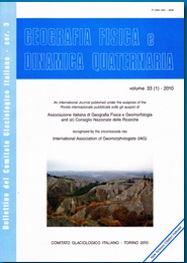
Ricerca & Innovazione > Contributi Scientifici
Leonelli G., Pelfini M., Panseri S., Battipaglia G., Vezzola L., Giorgi A.
First results of an innovative multi-proxy approach applied to glacierrelated trees for assessing climatic and substrate influence on tree rings and needle VOCs are reported. Tree-ring stable isotopes, tree-ring growth patterns and needle volatile organic compounds where analysed at two Larix decidua Mill. sites in five trees of similar size growing in close areas mainly differentiated by the contrasting geomorphological features: the debriscovered Miage Glacier (“Glacier”) and a lateral moraine (“Control”). Over the period 2003-2012, tree rings at the Glacier site showed more enriched 13C mean values (p<0.05) in the cellulose with respect to the Control site likely due to a lower stomatal conductance induced by low soil water retention, high temperature excursions and high exposure to direct solar radiation. Also 18O mean values were higher (p<0.01) at the Glacier site, likely due to the assimilation of shallow waters from a superficial root system of supraglacial trees, in contrast to a more developed and stabilized soil at the Control site. The analysis of tree-ring growth patterns of the sampled specimens provided a temporal insight of climatic and geomorphological stress at the Glacier site: here we found higher rates of positive abrupt growth changes (AGCs), but no differences in percent of latewood. Needles volatile organic compounds (VOCs) showed significant differences in some compounds of mono- di- and sesquiterpenes. Those with higher concentrations (b-myrcene and estragole) showed also the largest differences, with higher concentrations at the Glacier site. Tree rings stable isotopes and AGCs, as well as needles VOCs in supraglacial trees may be used as environmental stress indicators in the mid- to short-term, respectively, providing valuable proxies for the assessment of geomorphological and climatic change impacts in the glacial environments of the Alps.
